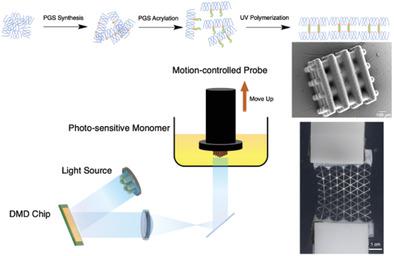当前位置:
X-MOL 学术
›
Adv. Funct. Mater.
›
论文详情
Our official English website, www.x-mol.net, welcomes your feedback! (Note: you will need to create a separate account there.)
3D Printing of a Biocompatible Double Network Elastomer with Digital Control of Mechanical Properties
Advanced Functional Materials ( IF 19.0 ) Pub Date : 2020-02-19 , DOI: 10.1002/adfm.201910391 Pengrui Wang 1 , David B Berry 2 , Zhaoqiang Song 3 , Wisarut Kiratitanaporn 4 , Jacob Schimelman 2 , Amy Moran 5 , Frank He 4 , Brian Xi 5 , Shengqiang Cai 6 , Shaochen Chen 7
Advanced Functional Materials ( IF 19.0 ) Pub Date : 2020-02-19 , DOI: 10.1002/adfm.201910391 Pengrui Wang 1 , David B Berry 2 , Zhaoqiang Song 3 , Wisarut Kiratitanaporn 4 , Jacob Schimelman 2 , Amy Moran 5 , Frank He 4 , Brian Xi 5 , Shengqiang Cai 6 , Shaochen Chen 7
Affiliation

|
The majority of 3D‐printed biodegradable biomaterials are brittle, limiting their application to compliant tissues. Poly(glycerol sebacate) acrylate (PGSA) is a synthetic biocompatible elastomer and compatible with light‐based 3D printing. In this article, digital‐light‐processing (DLP)‐based 3D printing is employed to create a complex PGSA network structure. Nature‐inspired double network (DN) structures consisting of interconnected segments with different mechanical properties are printed from the same material in a single shot. Such capability has not been demonstrated by any other fabrication techniques so far. The biocompatibility of PGSA is confirmed via cell‐viability analysis. Furthermore, a finite‐element analysis (FEA) model is used to predict the failure of the DN structure under uniaxial tension. FEA confirms that the DN structure absorbs 100% more energy before rupture by using the soft segments as sacrificial elements while the hard segments retain structural integrity. Using the FEA‐informed design, a new DN structure is printed and tensile test results agree with the simulation. This article demonstrates how geometrically‐optimized material design can be easily and rapidly constructed by DLP‐based 3D printing, where well‐defined patterns of different stiffnesses can be simultaneously formed using the same elastic biomaterial, and overall mechanical properties can be specifically optimized for different biomedical applications.
中文翻译:

具有机械性能数字控制的生物相容性双网络弹性体的 3D 打印
大多数 3D 打印的可生物降解生物材料都是脆性的,限制了它们在顺应性组织中的应用。聚癸二酸甘油酯 (PGSA) 是一种合成的生物相容性弹性体,与光基 3D 打印兼容。在本文中,采用基于数字光处理 (DLP) 的 3D 打印来创建复杂的 PGSA 网络结构。受自然启发的双网络 (DN) 结构由具有不同机械性能的互连部分组成,由相同材料一次性打印而成。迄今为止,任何其他制造技术尚未证明这种能力。PGSA 的生物相容性通过细胞活力分析得到证实。此外,有限元分析 (FEA) 模型用于预测单轴拉伸下 DN 结构的失效。FEA 证实,通过使用软段作为牺牲元件,DN 结构在破裂前吸收了 100% 以上的能量,同时硬段保持了结构完整性。使用基于 FEA 的设计,打印出新的 DN 结构,拉伸测试结果与模拟结果一致。本文演示了如何通过基于 DLP 的 3D 打印轻松快速地构建几何优化的材料设计,其中可以使用相同的弹性生物材料同时形成不同刚度的明确图案,并且可以针对不同的生物材料专门优化整体机械性能。生物医学应用。
更新日期:2020-04-06
中文翻译:

具有机械性能数字控制的生物相容性双网络弹性体的 3D 打印
大多数 3D 打印的可生物降解生物材料都是脆性的,限制了它们在顺应性组织中的应用。聚癸二酸甘油酯 (PGSA) 是一种合成的生物相容性弹性体,与光基 3D 打印兼容。在本文中,采用基于数字光处理 (DLP) 的 3D 打印来创建复杂的 PGSA 网络结构。受自然启发的双网络 (DN) 结构由具有不同机械性能的互连部分组成,由相同材料一次性打印而成。迄今为止,任何其他制造技术尚未证明这种能力。PGSA 的生物相容性通过细胞活力分析得到证实。此外,有限元分析 (FEA) 模型用于预测单轴拉伸下 DN 结构的失效。FEA 证实,通过使用软段作为牺牲元件,DN 结构在破裂前吸收了 100% 以上的能量,同时硬段保持了结构完整性。使用基于 FEA 的设计,打印出新的 DN 结构,拉伸测试结果与模拟结果一致。本文演示了如何通过基于 DLP 的 3D 打印轻松快速地构建几何优化的材料设计,其中可以使用相同的弹性生物材料同时形成不同刚度的明确图案,并且可以针对不同的生物材料专门优化整体机械性能。生物医学应用。


























 京公网安备 11010802027423号
京公网安备 11010802027423号